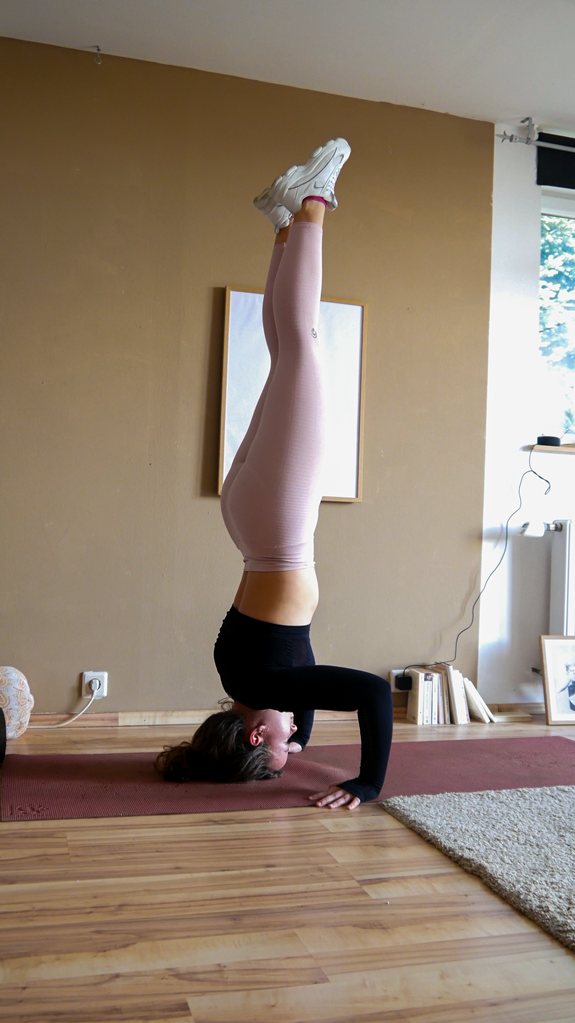Malin Loibner is a 17-year-old girl based in Austria, a passionate practitioner of yoga. Though not a yoga teacher, she shares tips and guidance about it on her Instagram account. The UN is now observing International Yoga Day on June 21 every year, but it is not yet ‘cool’ among her peers in Austria to either talk about it or practise it. In an interview to Chandan Kumar Singh, she answers a range of questions related to her passion.
Tell us briefly what attracted you to yoga.
My yoga journey started as a kid. I learned the basics of yoga by imitating my mother’s yoga sessions. As I got older, I continued to practise with my youngest sister and never went without it. The benefits of yoga, such as calmness, stretching and breathing, always bring me to it, no matter how tired I am.
When you start practising yoga, you will notice the calm flowing through your body, the pleasant stretch your body craves, how bending prevents you from breaking, the greatness of precise breathing and the brilliance of taking that time out just for yourself.
What’s your area of specialisation in yoga? Do you also teach it?
I have been primarily practising yin yoga, which is a slower, more meditative type that involves holding asanas and meditations. It is a powerful tool to reinforce positive thinking and promote self-love.
I am currently 17 years old, so I am not yet a yoga teacher. However, I am passionate about helping beginners start and build a yoga practice. My Instagram account is where I offer tips and guidance to help them along the way. I am excited to share my knowledge and passion for yoga with others and help them experience the many benefits that it has to offer.
What are the benefits of practising yoga?
There are numerous physical and mental benefits of practising yoga. It can improve flexibility, strength, balance and posture. Moreover, it can also help reduce stress, anxiety, depression and chronic pain. In addition, yoga is adaptable to all levels of fitness and can be practised anywhere with minimal equipment. With so many variations of yoga available, there’s something for everyone, regardless of age, fitness level, or lifestyle. So, yoga is a perfect choice for anyone looking to improve one’s physical and mental health, to stay fit and healthy.
How does your peer group in Austria see yoga?
In Austria, teenagers prefer to party on weekends, rather than practise yoga, which is often seen as an activity for older women. Many young people are interested in yoga but feel it is not “cool” to talk about it or practise it. After starting to post about yoga on Instagram, I was surprised by the number of people my age and also friends who asked for beginner tips. I believe it is unfortunate that many people are scared to try new things because of their surroundings. Don’t be afraid to take the first step and pursue your interests.
Given India’s leadership in the field of yoga, how do you see it?
I feel all must know the origin and birthplace of yoga, so that we can preserve it as an ancient practice taught through generations. India’s leadership in the field of yoga has played a significant role in spreading awareness about the practice and its benefits as well as in developing different styles of yoga.
However, I think yoga is becoming more modernised. Social media, especially, shows how many people are unaware of the origins of yoga. Even I need to work on that. As the popularity of yoga continues to grow, India’s leadership will always play a significant role in preserving and advancing this ancient practice.
‘There are numerous physical and mental benefits of practising yoga. It can improve flexibility, strength, balance and posture. It can also help reduce stress, anxiety, depression and chronic pain. In addition, yoga is adaptable to all levels of fitness.’
‘As the popularity of yoga continues to grow, India’s leadership will always play a significant role in preserving and advancing this ancient practice.’
Yin yoga poses are held for longer
By Malin Loibner
Yin yoga is a unique form of yoga that differs from other styles in a few key ways. The most significant difference is that poses are held for a longer duration, usually several minutes, as opposed to the more common dynamic flow of other yoga styles. This extended hold time allows the body to access and stretch the deep connective tissues, such as ligaments, tendons, and fascia, which are often overlooked in other styles of yoga.
Yin yoga also focuses on passive stretching, meaning that the practitioner relaxes into the pose and lets gravity do most of the work. Unlike other styles that use active stretching, which involves contracting the muscles to create movement, in yin yoga the muscles remain relaxed as the body sinks into the pose. This passive stretching helps to reduce tension and increase flexibility over time, without putting excessive stress on the joints.
Another unique aspect of yin yoga is the absence of warm-up exercises, such as sun salutations, which are common in many other yoga styles. The focus in it is on deep relaxation, and there is no need for the preparatory work that a warm-up provides. This makes yin yoga a great choice for people who want to stretch and relax without the energetic pace of other yoga styles.
Meditation and mindfulness practices are also an essential part of yin yoga. As the poses are held for a longer time, practitioners are encouraged to cultivate awareness of their breath and body sensations. This mindfulness practice helps to calm the mind and body, reduce stress and anxiety, and improve overall well-being.
Despite the long hold times and passive stretching, yin yoga is still accessible to people of all abilities. Its many poses have variations or modifications that can be used to make the poses more or less intense, depending on the individual’s needs. This adaptability means that yin yoga can be a great choice for those recovering from injury, managing chronic pain, or simply looking for a more gentle form of yoga.
In conclusion, yin yoga is a slower, more introspective form of yoga that emphasises deep relaxation, passive stretching, and mindfulness practices. It provides a unique opportunity to access and stretch the body’s deep connective tissues and can be beneficial for anyone seeking increased flexibility, reduced stress, and improved overall well-being.
(As told to Chandan Kumar Singh)
YOGIC ASANAS IN PICS

Utthita parsvakonasana or Extended Side Angle Pose
Benefits
- Strengthens the legs and core muscles
- Stretches the hips, groin, and hamstrings
- Opens the chest and shoulders
- Increases lung capacity
- Enhances concentration
Contraindications
- Knee injuries
- Hip injuries
- High blood pressure
- Heart problems

Anjaneyasana or Low Lunge or Crescent Lunge Pose
Benefits
- Stretches the hips, quadriceps, and thighs
- Strengthens the legs and glutes
- Improves balance
- Stimulates digestion
- Relieves stress and anxiety
Contraindications
- Knee injuries
- Ankle injuries
- High blood pressure
- Heart problems
- Lower back problems

Eka pada rajakapotasana or Pigeon Pose with Quad Stretch
Benefits
- Stretches hip flexors
- Stretches quadriceps
- Opens chest and shoulders
- Calms the mind
- Improves flexibility
Contraindications
- Knee or hip injury
- Lower back pain
- Pregnancy
- Recent surgery

Padmasana or Lotus Pose
Benefits
- Helps to calm the mind
- Increases focus and concentration
- Improves posture
- Stimulates digestion
- Helps to reduce menstrual discomfort
- Increases flexibility
Contraindications
- Knee or ankle injuries
- Lower back pain
- Hip injuries
- Pregnancy

Bhujangasana or Cobra Pose
Benefits
- Strengthens the back muscles
- Improves posture
- Stimulates digestion
- Increases flexibility
- Helps to relieve stress and fatigue
Contraindications
- Pregnancy
- Herniated disk or spinal injuries
- Carpal tunnel syndrome
- Recent abdominal surgery

Bhujangasana or King Cobra Pose
Benefits
- Strengthens the back muscles
- Stretches the chest and shoulders
- Improves flexibility
- Stimulates the digestive system
- Relieves stress
Contraindications
- Back injuries
- Pregnancy
- Carpal tunnel syndrome
- Recent abdominal surgery
- Headaches or migraines

Sirsasana or Headstand
Benefits
- Increased blood flow to the brain: Headstands help to increase blood flow to the brain, which can improve cognitive function and memory
- Relieves stress and anxiety
- Strengthens the upper body
- Improves digestion
- Boosts immunity
Contraindications
- Neck injuries
- High blood pressure
- Menstruation: Women should avoid practising headstands during menstruation as it can disrupt the flow
- Glaucoma
- Heart conditions

Eka pada ustrasana or One-Legged Camel Pose
Benefits
- Stretches the front body: One-Legged Camel Pose opens up the chest, shoulders, and quadriceps, stretches the hip flexors and abdomen, and helps to counteract the effects of sitting for long periods of time
- Improves posture
- Increases spinal flexibility
- Boosts energy and mood
Contraindications
- Low back pain or injury
- Neck or shoulder injury
- High blood pressure

Chakrasana or Wheel Pose
Benefits
- Strengthens the back muscles
- Opens up the chest
- Improves flexibility
- Relieves stress
- Stimulates the digestive system
Contraindications
- Pregnancy
- High or low blood pressure
- Neck or back injuries
- Migraines or headaches

Adho mukha svanasana or Downward-Facing Dog with Bent Knees
Benefits
- Stretches the back
- Strengthens the arms and shoulders
- Improves balance
- Relieves stress
- Provides relief for tight hamstrings
Contraindications
- Wrist or shoulder injuries
- High or low blood pressure
- Pregnancy
- Carpal tunnel syndrome








